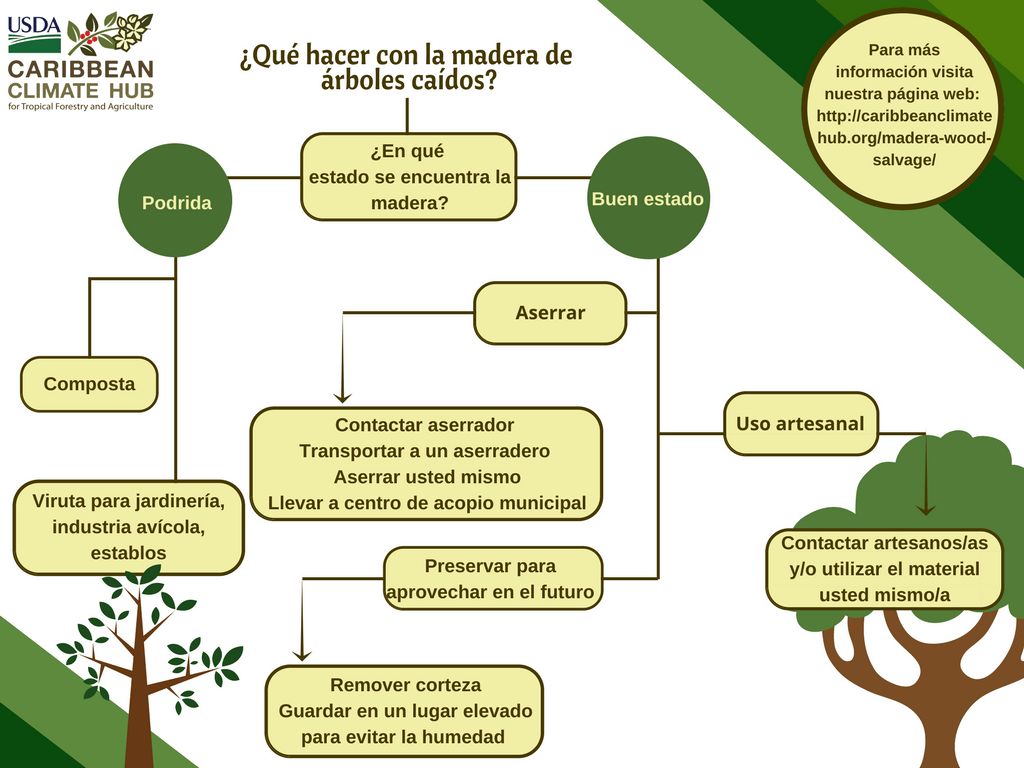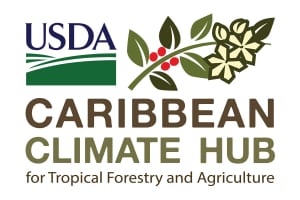Fallen trees: Trash or Treasure?
By Dr. William A. Gould, Director, USDA Caribbean Climate Hub, February 7 2018
The aftermath of hurricane Maria has left us with impressions, perceptions, problems, and stories. One of the stories, not yet finished, is fate of our fallen trees. Puerto Rico has nearly 1.5 billion trees growing in forests, along country roads and urban streets. Most are young and small diameter, but many are large trees of valuable tropical hardwoods.
The island was defoliated by the hurricane winds and for a moment we had a brown and barren landscape. It was heartbreaking to those who love trees! The truth is that most of our trees survived. Within a few days, new leaves began to appear. Four months later, we have recovered our green mantle.
Clearly not all of our trees survived. Fallen trees and branches blocked roads and damaged powerlines and infrastructure. It has been estimated that 20-30 percent of our trees have been downed or damaged.
Municipalities and agencies estimate hurricane Maria left over 5 million cubic yards of vegetative debris and hundreds of thousands of large trunks along public right of ways. The priority has been to clear roadways, remove debris blocking drainages to avoid flooding, and dispose of the material. Initial plans were to dispose in landfills or by burning.
These options overlook the tremendous value of trees and the need to manage them not as trash but as treasure! The wood is valuable as mulch, compost, charcoal and timber. In the salvage efforts we can grow our businesses and communities with equipment and knowledge to convert waste wood to valued resources.
Wood is a unique renewable resource that can support cultural and economic development. Currently, the vegetative waste being collected is chipped into mulch, with in many cases larger logs set aside for their value as lumber.
Once chipped, 5 million cubic yards of vegetative waste is equivalent to about 1.4 million cubic yards of mulch. High quality mulch is valued at anywhere from $10 to $65 per cubic yard. On the other hand, hardwood logs over 12 inches in diameter and six feet in length are worth saving. Hardwood prices vary from $5 to $60 dollars per board foot, and there is a tremendous value in using local wood to produce furniture, crafts, musical instruments, for vocational training and for export.
Salvaged wood chips and logs are changing through natural processes. Wood chips are decomposing but remain a valuable resource for farmers, gardeners, and land managers. The logs are susceptible to insects and decay. To protect their value they need to be stored and managed properly.
In Puerto Rio there are about a dozen commercial or community sawmills and a fledgling wood products industry that can be supported and serve as a foundation for a sustainable industry.
It is critical to act quickly to conserve these resources and salvage their value. Puerto Rico has expertise in composting, milling and wood processing. There are obstacles. The agencies concerned have to locate sites and transfer management of the material.
The first challenge is to salvage the material from the waste stream and develop agreements with local entities to manage this treasure for the benefit of all.
CHECK OUT OUR WOOD RECOVERY RESOURCES PAGE:
https://caribbeanclimatehub.org/madera-wood-salvage/
DOWNLOAD AND SHARE OUR FACT SHEETS ON HOW TO SALVAGE AND REUSE WOOD OF FALLEN TREES!
All the information is available in English and Spanish.
Este artículo fue publicado en El Nuevo Día en español: https://www.elnuevodia.com/opinion/columnas/arbolcaidobasuraotesoro-columna-2397612/






Follow Us!